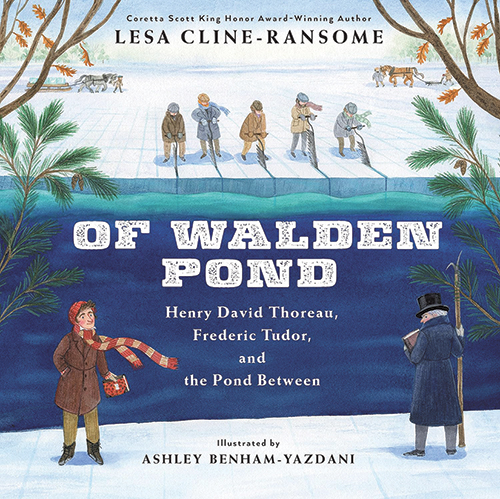
Of Walden Pond: Henry David Thoreau, Frederic Tudor, and the Pond Between
Reviewed by Anne E.G. Nydam
December 1, 2023
By Lesa Cline-Ransome, illustrated by Ashley Benham-Yazdani. Holiday House, 2022. 40 pages. $18.99/hardcover; $11.99/eBook. Recommended for ages 6–9.
This book uses poetic words and beautiful watercolor and pencil illustrations to compare the stories of two men whose lives intersected at Walden Pond in Massachusetts in the middle of the nineteenth century. The more famous Henry David Thoreau built his cabin by Walden Pond with the vision of living simply amid nature. Frederic Tudor brought a team of men to the pond with the goal of harvesting its ice and shipping it to India.
If you’re looking for a book in which transcendentalist Thoreau is the hero while capitalist Tudor is the villain, this is not it. Instead the author beautifully draws the parallels between the two men, as well as their different ways of looking at Walden Pond. They were both, in their own ways, dreamers who each dared to follow a vision despite the skepticism of most of society. They both influenced our lives today: Thoreau with his book Walden; or, Life in the Woods and Tudor with his pioneering methods of insulation that led the way toward refrigeration. Because we don’t have his own words, we don’t know whether Tudor appreciated the natural beauty of Walden Pond, but we do know that Thoreau was fascinated by the idea of Walden’s ice going all the way to India. As for myself, I really appreciate the way this book is not a sermon but rather a musing on the way Walden Pond was so central to both men in such different ways.
The text explains in a series of lyrical vignettes both what the two men are doing and their motivations, while it also celebrates the beauty of Walden Pond. It takes the form of poetry, each page ending with the refrain “of Walden Pond.” The illustrations use both realistic detail and dreamlike perspectives to show the pond in every season, as well as details of Thoreau’s cabin, Tudor’s ship, and the voyage to India. Words and pictures stitch together a connection, not just between Thoreau and Tudor but also between Concord and Calcutta.
This book does a beautifully open-ended job of inviting the reader to think about the issues of what dreams we have and how we might follow them; what our relationship is with nature, and how we might both care for it and take what we need from it; and how people with very different motives and lives might actually have more in common than we might at first imagine. It serves as an introduction to both Thoreau and Tudor, and the author’s note at the end gives some additional details to the history and biographies, providing even more meat to the interesting questions raised. I think this book has enough depth to be enjoyed and discussed by children age six right up through adults.
Anne E.G. Nydam is a member of Wellesley (Mass.) Meeting. A former middle-school art teacher, she now works as an author and artist.



Comments on Friendsjournal.org may be used in the Forum of the print magazine and may be edited for length and clarity.